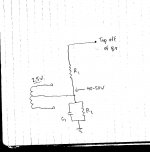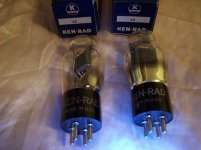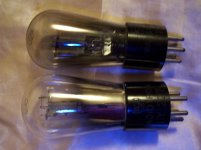A note about the 27's, I have rotated 9 pairs of them through and the globe mesh plates have the most delicate transparent sound. The solid plate st's sound slightly harsh to my ears.
Cheers, Mike
Hey,
Thanks for posting this. I've got a NOS 45 and 27 sitting in the box and have been planning a SE amp with. Good to hear someone using the 27. It seems to get a bad rap sometimes. Look forward to trying the circuit you posted out.
Am also looking for an OT for this project that has a 600r line tap in addition to the speaker taps. Rare item among modern iron. Hammond would do it - likely for the price of a James though. If anyone has such a beast they'd be willing to part with give me a shout.
Lasso,
I have removed the 1k plateload resistors on the 27, used seperate 10hy or higher choke to load the plates thru 27k resistor. After I have done this as per advise from kevin kennedy in a previous post, all is wonderfull. I thought, what is the big problem with the 27,... those using scopes to detect freq response curves. Most of the time the freq's are out of human hearing anyway or at least mine, are what people rave about. I build for myself and family, and have had zero complaints. 🙂
The mesh plate 27 to me sounds just sweet and shimmering. Use quality signal caps and good iron and it will put a smile on your face. Also, I have removed the paraphase arangement for the output tube, meaning I remove the choke to plate and connected B+ to the opt as for normal SE use.
When I can get to it, i'll post updated circuit. Mind you, I am no expert here just a diehard DIY'er using tubes for the pleasure of music. 🙂
I have removed the 1k plateload resistors on the 27, used seperate 10hy or higher choke to load the plates thru 27k resistor. After I have done this as per advise from kevin kennedy in a previous post, all is wonderfull. I thought, what is the big problem with the 27,... those using scopes to detect freq response curves. Most of the time the freq's are out of human hearing anyway or at least mine, are what people rave about. I build for myself and family, and have had zero complaints. 🙂
The mesh plate 27 to me sounds just sweet and shimmering. Use quality signal caps and good iron and it will put a smile on your face. Also, I have removed the paraphase arangement for the output tube, meaning I remove the choke to plate and connected B+ to the opt as for normal SE use.
When I can get to it, i'll post updated circuit. Mind you, I am no expert here just a diehard DIY'er using tubes for the pleasure of music. 🙂
Sounds good. I would imagine the cross talk with the shared choke could be annoying at times. I have a pair of SE 6BQ5 amps that share a cathode resistor and I've concluded I don't like that arrangement.
One other thing of note - I noticed you're using a single filament winding for all four tubes. I've always heard "use two separate windings for 45s". Sounds like yours is doing ok though. Keep us posted.
One other thing of note - I noticed you're using a single filament winding for all four tubes. I've always heard "use two separate windings for 45s". Sounds like yours is doing ok though. Keep us posted.
Sounds good. I would imagine the cross talk with the shared choke could be annoying at times. I have a pair of SE 6BQ5 amps that share a cathode resistor and I've concluded I don't like that arrangement.
One other thing of note - I noticed you're using a single filament winding for all four tubes. I've always heard "use two separate windings for 45s". Sounds like yours is doing ok though. Keep us posted.
Funny or not I came to about the same conclusion wrt to shared cathode resistors which are not too uncommon in PP stereo 6BQ5 amps either. Dyna ST-35, and SCA-35 are immediate examples that spring to mind.. My very first stereo SE amp as a teen was a repurposed magnavox with shared cathode bias.
I'd recommend separate filament windings for 45 with cathode bias, but if you are using fixed bias a shared winding is just fine except for the inconvenience involved in measuring plate currents. In this case the I think the cathode bias on the winding is helping to keep the 27 cathode to filament interface from misbehaving - much higher voltages though may cause the cathode to filament insulation to fail in these tubes - I learned this the hard way..
Normally I'd recommend the 27 filaments be biased about 20 - 25V above the cathode, but not substantially more than this. Using the output stage cathode bias to do this is probably ok as the voltage differential is still less than 40 - 50V which is where I experienced problems, and as long as the cathode bypass cap is a good one hopefully there will be no significant coupling through the 27 filament capacitance.
Heck, it works, and sounds good, all refinements can follow from a working prototype.. 😀
Last edited:
Thanks for the heads up on the 27 cathode-filament interface. This will be my first time working with the 27. That sounds like some good information to know.
Something like this:? (note: meant to write as 20-25V instead of 40-50V)
Normally I'd recommend the 27 filaments be biased about 20 - 25V above the cathode
Something like this:? (note: meant to write as 20-25V instead of 40-50V)
Attachments
Thanks for the heads up on the 27 cathode-filament interface. This will be my first time working with the 27. That sounds like some good information to know.
Something like this:? (note: meant to write as 20-25V instead of 40-50V)
Exactly. 😀
These are matched pairs (quite close)..
And your favorite was?
Building a 45 set at the moment but don't own the tubes,...yet.
J
And your favorite was?
Building a 45 set at the moment but don't own the tubes,...yet.
J
The majestic globe 27's w/mesh plate's for the input and Kenrad 45's are my current favs. I only have two pair of 45's, The kenrads and a pair of raytheons.
Cheers, mike
Cheers, mike
Other's may sound better to your ears, and at varying operating points.The majestic globe 27's w/mesh plate's for the input and Kenrad 45's are my current favs. I only have two pair of 45's, The kenrads and a pair of raytheons.
Cheers, mike
I am no expert here, just build for the pleasure of music and gratification of creating it myself. If I had the energy, I would build audio equipment for a living. Right now, I do not have the equipment to provide documentation of distortion or Db levels ect. My ears and common sense using mr. OHM and Kirchoff works for me.
It becomes difficult here, because most of my Iron have zero documentation, so at times it becomes a guestimate of sorts and over compensate and maintain strict saftey procedures. Yess, rambling of topic again, sorry.
Have a great day
Mike (mltube)
Just a sample of tubes I have rolled into this experiment... 😛
These are matched pairs (quite close)..😉
Hi Mike,
I managed to get hold of a set of 26s, on their way from the US at the moment 🙂
Was keen to see your latest circuit updates and results particularly on the driver stage?
Cheers,
Ale
"A mistake is always forgivable, rarely excusable and always unacceptable. " (Robert Fripp)
Have you measured your stereo separation?
Is this an over estimated feature ?
I looked the specification of hi-end MC-cartridges and those have some 25 dB stereo separation in average.
Hi!
The 45 belongs to my favorite tubes. The 27 is a great choice as driver, albeit maybe a bit low in gain, but if the system has enough gain it's great. I had a 27/45 in the past and spent a step up input transformer to get a bit more gain. I have a 45 amp in my commercial offering and there I use a 6N7 (both sections paralleled). That gives just the right gain. The 6N7 is a great tube which gets less attention than it deserves, maybe because the two halves need to be used in parallel (they have a common cathode). Good for me because that keeps the prices low 🙂
I plan to take a 26/45 into my amplifier lineup. Will start construction soon.
One caveat about mesh 27s. I tested many on a curve tracer and found that a lot of them have very irregular plate curves. Often the electrodes are misaligned which causes this. The ST shape 27s I measured all had very linear curves.
here some pics of my 45 amp, stereo with external PSU:
ImageShack® - Online Photo and Video Hosting
ImageShack® - Online Photo and Video Hosting
Best regards
Thomas
The 45 belongs to my favorite tubes. The 27 is a great choice as driver, albeit maybe a bit low in gain, but if the system has enough gain it's great. I had a 27/45 in the past and spent a step up input transformer to get a bit more gain. I have a 45 amp in my commercial offering and there I use a 6N7 (both sections paralleled). That gives just the right gain. The 6N7 is a great tube which gets less attention than it deserves, maybe because the two halves need to be used in parallel (they have a common cathode). Good for me because that keeps the prices low 🙂
I plan to take a 26/45 into my amplifier lineup. Will start construction soon.
One caveat about mesh 27s. I tested many on a curve tracer and found that a lot of them have very irregular plate curves. Often the electrodes are misaligned which causes this. The ST shape 27s I measured all had very linear curves.
here some pics of my 45 amp, stereo with external PSU:
ImageShack® - Online Photo and Video Hosting
ImageShack® - Online Photo and Video Hosting
Best regards
Thomas
Hi!
IMHO yes! I get often the question why I rarely build mono amps but rather stereo with external PSU. As was mentioned before MC cartridges typically have very low channel separation, so that a few dB less in the amplification does not really matter.
I think the sound degradation which people observed with common cathode resistors between channels is not related to stereo separation. I always spend separate cathode resistors even in PSE amps for each tube. So each tube finds it's own optimal op point. With shared cathode resistors the tube with more emission hogs most of the current and the other one is left 'starving'
Best regards
Thomas
Is this an over estimated feature ?
IMHO yes! I get often the question why I rarely build mono amps but rather stereo with external PSU. As was mentioned before MC cartridges typically have very low channel separation, so that a few dB less in the amplification does not really matter.
I think the sound degradation which people observed with common cathode resistors between channels is not related to stereo separation. I always spend separate cathode resistors even in PSE amps for each tube. So each tube finds it's own optimal op point. With shared cathode resistors the tube with more emission hogs most of the current and the other one is left 'starving'
Best regards
Thomas
Is this an over estimated feature ?
I looked the specification of hi-end MC-cartridges and those have some 25 dB stereo separation in average.
Yes, in my opinion too. I started out building amps with separate power supply or supply finals for each channel. Later testing showed a small amount of crosstalk with a single supply, but I could not hear the difference. If I split supplies now, it's between stages, not channels.
Same is somewhat true for bias supplies for a fixed bias amp. I use a single supply, and split it before the final RC if I need to reduce crosstalk. But I no longer try to reduce it to zero.
It's simple to test. Run an input into one channel and measure the signal level. Compare that to the undriven channel. If you are 35-40dB down, there's not much to gain by trying for 60dB.
Sheldon
I think the sound degradation which people observed with common cathode resistors between channels is not related to stereo separation. I always spend separate cathode resistors even in PSE amps for each tube. So each tube finds it's own optimal op point. With shared cathode resistors the tube with more emission hogs most of the current and the other one is left 'starving'
This makes good sense and is probably a major contributor to why I tend to dislike the sound of SE amps using this arrangement.
I managed to get hold of some 27s, they don't have a lot of gain though, what is the best driver circuit for the 45?
Thanks
Ale
"A mistake is always forgivable, rarely excusable and always unacceptable. " (Robert Fripp)
Thanks
Ale
"A mistake is always forgivable, rarely excusable and always unacceptable. " (Robert Fripp)
Hi Thomas,
Yes 6sn7 is a great valve for phase spliter, problem is that I have only one, and can't find any cheap Similar ones around.
I originally considered a 6sl7 in a symmetrical totem pole configuration or similar which can easily give a gain of 27db
Regards,
Ale
Yes 6sn7 is a great valve for phase spliter, problem is that I have only one, and can't find any cheap Similar ones around.
I originally considered a 6sl7 in a symmetrical totem pole configuration or similar which can easily give a gain of 27db
Regards,
Ale
- Status
- Not open for further replies.
- Home
- Amplifiers
- Tubes / Valves
- Back at the 45 SET



